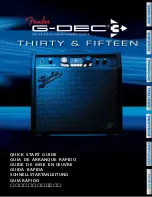
14
User’s Guide OctaMic II
© RME
9. External Synchronization
The digital inputs of the OctaMic II are used for external synchronization only. In case the clock
shall not be generated internally (operation mode Master), an external synchronization (opera-
tion mode Slave) is available via word clock or AES (SPDIF).
The SteadyClock technology of the OctaMic II guarantees exceptional performance in all clock
modes. Thanks to a highly efficient jitter suppression, the AD-conversion always operates on
highest sonic level, being completely independent from the quality of the incoming clock signal.
When the current word clock source fails, the last valid sample rate will be held automatically.
9.1 Word Clock - BNC
The word clock input is activated by DIP switches 1 and 2. Both switches must be set to their
lower position.
Thanks to RME's
Signal Adaptation Circuit
, the word clock input still works correctly even with
heavily mis-shaped, dc-prone, too small or overshoot-prone signals. Thanks to automatic signal
centering, 300 mV (0.3V) input level is sufficient in principle. An additional hysteresis reduces
sensitivity to 1.0 V, so that over- and undershoots and high frequency disturbances don't cause
a wrong trigger.
The word clock input is shipped as high impedance type (not terminated). A push switch allows
to activate internal termination (75 Ohms). The switch is found beside the BNC socket. Use a
small pencil or similar and carefully push the blue switch so that it snaps into its lock position.
Another push will release it again and de-activate the termination.
Due to the outstanding clock control a synchronization of the output signal to the input signal is
not only possible at identical sample rates, but also at half, quarter, double and quad sample
rates.
Example 1
: DIP switch 3/4/5 in upper position results in a sample rate of 44.1 kHz. The external
synchronization source (word clock or AES) can now be 44.1 kHz, 88.2 kHz or 176.4 kHz.
Example 2
: DIP switch 3/5 in lower position results in a sample rate of 192 kHz. The external
synchronization (word clock or AES) source can now be 48 kHz, 96 kHz or 192 kHz.
9.2 AES – D-Sub
Using the D-sub connector, an AES, AES/EBU or SPDIF signal can be used for synchroniza-
tion. Set DIP switch 1 to the upper position and DIP switch 2 to the lower position.
The OctaMic II's synchronization input uses AES 1 (see chapter 11.1). The input is transformer-
balanced and ground-free.
Thanks to a highly sensitive input stage, a
SPDIF signal can also be fed by using a
simple cable adapter phono/XLR. To
achieve this, pins 2 and 3 of an XLR plug
are being connected to the two contacts of a
Phono/RCA plug. The ground shield of the
cable is only connected to pin 1 of the XLR
plug.
With AES synchronization is possible not only at identical sample rates, but also at half, quarter,
double and quad sample rates.
Summary of Contents for OctaMic II
Page 4: ...4 User s Guide OctaMic II RME...
Page 5: ...User s Guide OctaMic II RME 5 User s Guide OctaMic II General...
Page 10: ...10 User s Guide OctaMic II RME...
Page 11: ...User s Guide OctaMic II RME 11 User s Guide OctaMic II Usage and Operation...
Page 15: ...User s Guide OctaMic II RME 15 User s Guide OctaMic II Inputs and Outputs...
Page 22: ...22 User s Guide OctaMic II RME...
Page 23: ...User s Guide OctaMic II RME 23 User s Guide OctaMic II Technical Reference...
Page 32: ...32 User s Guide OctaMic II RME 15 Block Diagram...















































